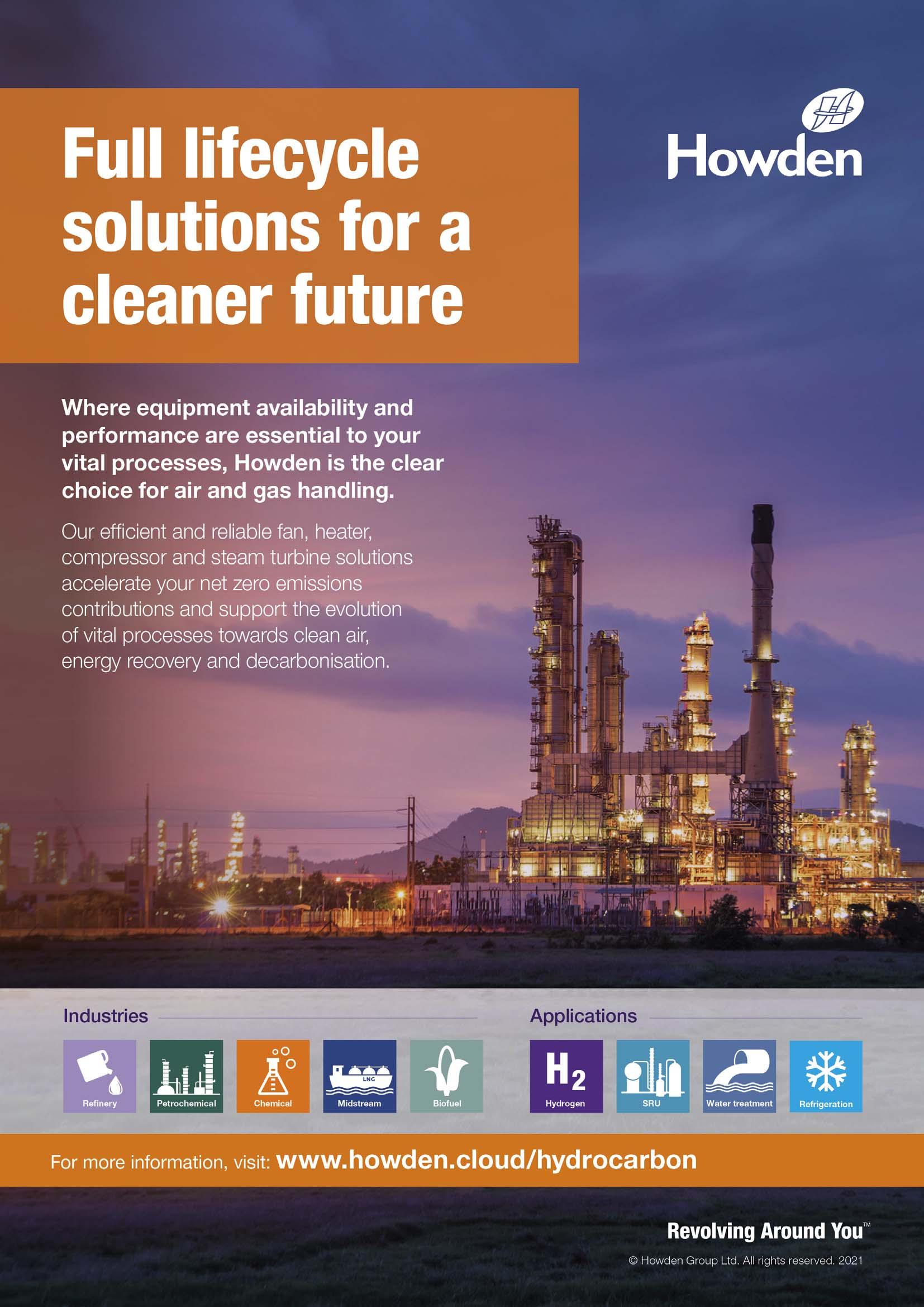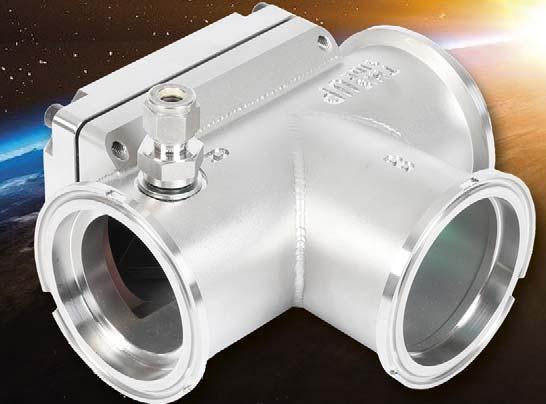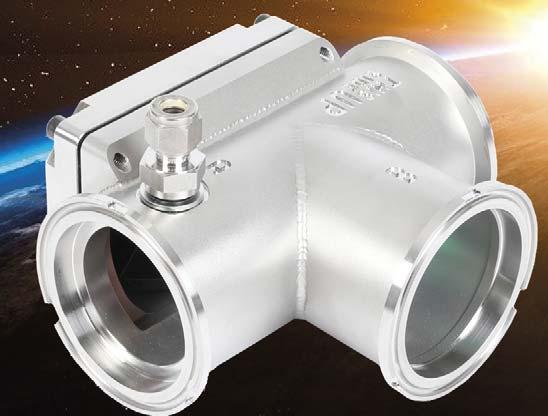
35 minute read
Compressor Q&A

Hydrocarbon Engineering talks to a number of leading experts in compressor technology about efficiency, equipment reliability, safety and the environment, digitalisation, and life after the COVID-19 pandemic.


Ben is the Process Compressor Sales & Market Development Specialist for Ariel Corp., located in Mount Vernon, Ohio, US. His responsibilities include the sizing and selection of Ariel’s API-618 Moderate Speed Process compressors and consulting with Ariel distributors, end-users and EPCs on their compression requirements. He has over 35 years of experience with reciprocating compressors; primarily those associated with the refi nery and petrochemical industries.
Sami Tabaza is the Gas Processing Market Manager for Atlas Copco’s Gas and Process Division. With more than a decade of experience in turbomachinery business development, marketing and applications engineering, Sami has held various positions in the US and Middle East. He currently oversees gas processing centrifugal compressor applications in the NGL and fractionation plants, focusing on process improvement, product optimisations, and standardisation.
Ben Berwick, Product Manager, Cook Compression
Ben Berwick joined Cook Compression in 2020, bringing 25 years’ experience creating technology solutions for increased reliability and effi ciency of industrial rotating machinery and compression systems. Ben previously served in design engineering, strategic marketing, and leadership roles for Bently Nevada Corp., Dresser-Rand, Rolls-Royce Power Systems, and Honeywell Process Solutions.


Brian Pettinato is Manager of Aero and Structural Dynamics at Elliott Group in Jeannette, Pennsylvania, US. He has been with Elliott Group since 1995. His primary area of expertise is machinery dynamics. Brian is a fellow member of ASME, a member of STLE, and a registered Professional Engineer in the State of Pennsylvania. He serves on the Turbomachinery Advisory Committee of Texas A&M and on the API 684 rotordynamics task force.
Richard Smith, Director of Product Strategy, Howden
Richard has approximately 40 years of experience in providing practical customer solutions for process applications combining thermodynamics and rotating machinery. Initially orientated toward heat transfer and change of state involving heavy slow rotation machinery, an early career change toward gas compression developed a broad experience across the power generation, mineral refi ning, petrochemical, and general heavy industries. High power applications involving fans, rotary, reciprocating compressors coupled with the high speeds of turbo technologies, have created solid foundations to recognise and provide optimum and reliable process solutions.

Pallavi Baddam is the Manager of US Applications Engineering & Process Automation at Mitsubishi Heavy Industries Compressor International (MCO-I) in Houston, Texas, US. Pallavi began her career as a control systems engineer for gas turbines with Rolls-Royce Energy Systems Inc. (now Siemens Energy). She later worked for Dresser-Rand Co. as a Proposal Development Engineer prior to joining Mitsubishi Heavy Industries where she leads the application engineering group and also heads the development of automated design tools. She has extensive experience (over 15 years) in turbomachinery used for the oil and gas industry and has worked on many challenging projects.

Explain why compressor technology is so crucial to downstream operations.

Ben Williams, Ariel Corp.
Compressor technology, whether it be selection tools, improvements in components, monitoring, predictive maintenance, or an advanced support network, all lead to improved reliability. Reliability is key in the downstream industry. Downstream compressors must meet the demanding requirements of the industry and run for extended periods between shutdowns.
Reciprocating compressors must continue to operate reliably while being subjected to changing operating conditions, gas compositions or capacity (flow) requirements. The design and materials of construction for compressor components such as valves, seals and capacity control devices are crucial to reliable operation.
Ben Berwick, Cook Compression
Compressors are fundamental to the operation of downstream facilities. Similar to the crucial role that pumps serve in moving liquids, compressors generate the necessary pressure rise to move gases – of varied type and purpose – throughout a downstream facility. From the crucial yet relatively low pressure (150 psi) plant utility air systems serving instruments, pneumatic tools, rotating devices, and plant control devices, to the 50 000 psi hyper compressors essential for low density polyethylene (LDPE) production, compressors serve a wide breadth of applications.
Whether reciprocating, centrifugal, or screw type, compressors are typically a large energy consumer, are essential to continuous production, and must reliably and safely transport high pressure and often hazardous gases throughout numerous plant processes. Accordingly, compression technology – encompassing the electrical systems that control and monitor compressors, to the mechanical parts and engineered materials of their componentry – is crucial for minimising energy consumption, downtime, and risk to plant personnel and the environment we all share.

Brian Pettinato, Elliott Group
Downstream operations such as oil refining, chemical, and petrochemical processes operate on a continuous basis often going anywhere from 3 to 10 years without ever shutting down. Each centrifugal compressor is an essential part of these processes constituting a major capital expense that is engineered to order and often the determining factor for plant or process throughput. Compressors require a considerable amount of energy and expense to operate. So, of course, compressor technology is quite crucial. Compressor technologies that address such typical concerns as efficiency, range, durability, and safety have been under continuous development from the beginning. More recent technologies include developments for reduced emissions, reduced noise, and improved operational flexibility.
Pallavi Baddam, Mitsubishi Heavy Industries Compressor International (MCO-I)
Downstream applications such as petrochemical operations involve many complex processes where boosting the pressure of the gas helps promote catalytic reactions, thermal decomposition, refrigeration operations and generation of byproducts. For example, in an ethylene plant, the hydrocarbon feedstocks are cracked at temperatures between 1470°F and 1580°F (800°C and 860°C). The cracked gas is then quenched and cooled before it enters the compressor. The compressed crack gas goes through acid removal, drying and cryogenic separation processes (i.e. further fractionation) in order to separate into different byproducts such as ethylene and propylene, etc. Multiple compressors are used in the above process, i.e. for cracked gas compression, ethylene and propylene refrigeration. Compressors are crucial in these processes as they strongly influence overall plant performance, efficiency (power consumption), and operational reliability, including safety and environmental impact.






How can compressor technology help to improve efficiency in gas processing and downstream operations?
Ben Williams, Ariel Corp.
Improved efficiency can come in many forms; the efficiency at which the compressor operates when compressing gas, the efficiency with which it meets varying operating conditions, extended operating hours between maintenance needs, or the efficiency at which replacement parts and capable service providers are available. All of these ‘technologies’ improve the operations experience.
Sami Tabaza, Atlas Copco’s Gas and Process Division
Selecting the right compressor technology based on the application and plant’s operation philosophy is key for improving the throughput of the plant. Operators examine compressor equipment from various efficiency angles: CAPEX, OPEX, power efficiency, emissions, as well as footprint. These aspects are all considered efficiencies, and they provide the reason why plant owners and operators tend to select compression technology specific to their plant’s applications.




IGC, for example, has high power effi ciency and meets other required effi ciencies relevant to CAPEX/OPEX/footprint. This is due to how it is designed and optimised. As an example: in refrigeration compressors where the compressor’s effi ciency drives the complete refrigeration cycle’s coeffi cient of performance (COP), the compressor technology improves overall gas plant effi ciency.
Brian Pettinato, Elliott Group
Downstream operations are often looked at holistically. Simply stated, it is the overall effi ciency that matters, and this is inclusive of the compressor, driver, and overall plant. The fi rst step is to properly select and match the compressor to the requirements of the process, not just at a best effi ciency point, but over the map of expected operation. Just as important is a good match between the compressor and the driver. Overall effi ciency is essentially an exercise in multi-variable optimisation, and this is heavily dependent on available technology.
Centrifugal compressor technology has never stopped advancing. Stage effi ciency has been improving via increasingly sophisticated 3D impeller and return system geometries and application of improved surface fi nishes. The effi ciency of stacked stages has been improving via better stage-to-stage matching. Effi ciency is better maintained over the long-term by wash systems and coatings that prevent compressor fouling and erosion. Compressor effi ciency is further improved by management of secondary fl ows using advanced seal concepts. Finally, reduction of parasitic power losses at bearings and other locations provide further energy savings. Effi ciency continues to improve as more advanced technology is put into play.
Richard Smith, Howden
Effi ciency improvements in downstream operations is often a factor of utilisation and hence compressor reliability is a key factor.
The basics of compressor technology have all been long established and, as a whole, the industry and its key players are mature. Continuous developments in materials, lubricants, seal and valve design, together with computer aided analysis and design, all combine to provide marginal improvements in effi ciency, reliability and extended mean time between maintenance (MTBM). For effi cient operation, it is imperative that the correct compressor technology is selected based upon: 1. Volumetric fl ow, pressure rise, static pressure range, temperature range. 2. Continuous or intermittent operation. 3. Flow and pressure regulation requirement.
It is this third criteria of fl ow and pressure regulation that is too often overlooked in helping to improve effi ciency in downstream operation. Plants rarely operate at design and hence the ability of the selected compression technology, together with its capacity control technology to maintain high effi ciency away from design fl ow or pressure, can signifi cantly infl uence plant operation. Additionally, today’s process requirements often operate on shorter timescales as customers are producing more on demand.
Pallavi Baddam, MCO-I
In the example of an ethylene cracker plant (provided in my previous answer), compressors constitute the largest energy consumption. Typically, petrochemical plants spend millions of dollars each year in fuel for steam production or electricity to power these compressors. Compressor power consumption is directly proportional to its overall polytropic effi ciency, and therefore every percent of effi ciency improvement translates to reduction in overall power consumption and plant operating costs.




What steps do you take to improve equipment reliability and safety?
Ben Williams, Ariel Corp.
Reliability begins with the compressor selection. With a reciprocating compressor, lower piston speeds, reduced discharge temperatures and lower valve impact velocities will all improve the life of the non-metallic wear parts. These items are taken into consideration when making the initial compressor selection. Ariel provides an industry leading compressor selection tool and offers a line of moderate speed reciprocating compressors specifi cally designed to meet the reliability requirements of the downstream industry.
Established limits, design guidelines and work instructions/procedures must be followed to ensure safe and reliable operation of a reciprocating compressor.
Sami Tabaza, Atlas Copco Gas and Process
Equipment reliability is the probability of a machine or an individual component to deliver the intended function within the given conditions for a given time duration. By defi nition, safety means to be free from an unacceptable risk of harm. The original equipment manufacturer (OEM) bears responsibility for part of this aspect, while the other part of the

responsibility lies with the operators and process team at site (for example, to follow recommended operation and maintenance procedures). Equipment reliability and safety is directly associated with its quality.
The knowledge and experience of proven design, manufacturing processes, quality procedures and onsite or fi eld tests are essential to delivering a quality machine. This results in higher reliability and safety. For the compressor OEM, for example, it starts with the design stage of the equipment: sizing the machine and its individual components in a proper way, selecting the right materials for the site conditions, plant location and process, engineering calculations (i.e. computational fl uid dynamics, fi nite element analysis, etc.). Installing a proper asset performance monitoring system (i.e. temperature and vibration monitoring probes and system) is another example. All of these steps are very important for the reliability of this critical equipment in a gas plant or in downstream operations.
Lastly, I always encourage our teams to look very closely at what surrounds the designed equipment and the circumstances associated with different mode of operations. So, if there is anything that needs to be looked at and addressed in that context, it is done during machine design and manufacturing.

Ben Berwick, Cook Compression
Cook Compression closely equates reliability with safety. The reliability of compressor components is foundational to ensuring overall safe compressor operation. It is too easy to surmise that some compressor component failures may only have a small consequence. Even where a failure results in considerable production or capital loss, those negative outcomes remain small and inconsequential relative to the ever-present likelihood that a compressor component failure could lead to a systemic failure – causing personal injury or the release of an explosive or environmental hazard. This is especially true for the high stresses that compressor valves, packings and sealing components endure. The solution for reliability is in two parts: in the component design and in proper maintenance.
For downstream applications, Cook Compression designs components to the particular circumstances of each application, including but not limited to the range of expected gas composition, speed range, pressures, gas loads, lubrication and temperature range. Engineers then optimise the component designs by drawing from a breadth of common and specialty materials to ensure reliability and safety, as well as to maximise effi ciency and longevity. Once installed and run for a period of time, component reliability depends on the aforementioned application-specifi c design as well as adherence to recommended maintenance activities.
Long-term best practices for maintenance include evaluating changing operating conditions, such as those that might arise from feedstock property changes. Given the decades-long lifespan of most reciprocating compressors, they are likely to operate with different gas compositions, pressures and output requirements at various points in their life. When such changes occur, the cycle of reliability must begin again, including a re-evaluation of the components’ suitability for safe and reliable operation under the new conditions and, where necessary, a new optimised design.


Brian Pettinato, Elliott Group
Quality, reliability and safety are very much inter-related. The starting point is people: their knowledge, training, communication, discipline to processes, ability to perform clean hand offs, their ability to ask ‘what could go wrong?’, and empowerment to apply foresight and make necessary changes. Of course, even with good people, there are always improvements to be found. Robust quality and corrective action systems are essential to ensure that necessary changes make it back to the people and vendors, and then into designs, procedures, and systems. The thought process for a good safety decision also applies to quality, and reliability. Technology development is only slightly different in that we intentionally go well beyond operational limits and actually confi rm wear, breakage, instability, and other failure mechanisms for the purpose of establishing robust margins that improve the safety and reliability of our products.


Richard Smith, Howden
Safety is at the core of what we do throughout our business. Our commitment to safety is embedded throughout all departments and locations in Howden. Our people and processes foster this culture across product lifecycle including design, manufacturing and testing, to transport, installation and operation as well as maintenance.
Safety and awareness training is carried out frequently within Howden, where performance is monitored and challenged monthly at board level in pursuit of achieving zero accidents. Additional experience from even minor incidents is circulated both internally and externally via safety alert notifi cations.
With over 160 years of engineering excellence, Howden is recognised as a trusted supplier of reliable compressors that meet the demands and specifi cations of continuous critical service applications, often operating in harsh environments. For Howden, continuous improvement of equipment reliability and safety is carried out through design. It is also important to recognise that reliability directly affects safety, not only the consequences of a catastrophic failure, but more that lack of reliability usually demands human intervention – and working on site is an increased risk for safety.
Howden Uptime, the company’s performance analytics tool, supports the implementation of new processes in the digital refi nery. It delivers actionable insights into how equipment is operating under specifi c conditions. This insight can predict when equipment needs maintenance, which can then be used to prevent any cases of unexpected downtime resulting in cost savings, increased reliability and increased safety.




Pallavi Baddam, MCO-I
Centrifugal compressors handling high pressure and high density gas can sometimes encounter rotor instability, high bearing temperatures and vibrations while in operation. MHI has continuously improved the reliability of compressors by coming up with various ways to attenuate the rotor vibration by performing various rotor dynamic analyses during the design stage and mechanical run tests.
Typically, in a cracked gas compressor, fouling is a common phenomenon which not only has a crippling effect on compressor performance but also causes the unit to shut down due to increased vibration levels. Thus in order to ensure safe and reliable operations, we use anti-fouling techniques such as SermaLon coating to avoid corrosion and foulant deposition on the surfaces and water injection to avoid the polymerisation at high temperatures, by keeping the gas temperatures lower.
Incorporating features such as remote monitoring helps with predictive maintenance of the equipment, thereby allowing us to take early action prior to fault detection. The goal behind remote monitoring is to increase the availability by avoiding unscheduled maintenance and minimise the scheduled down time.
In addition to this, solutions such as extended overhaul intervals, smaller maintenance windows, compact and light equipment, modularisation or package standardisation as a means of reducing cycle time and cost, all help to ensure safe and reliable operations.

How can compressor technology assist plants operating in extreme environments or with demanding applications?

Sami Tabaza, Atlas Copco Gas and Process
Flexible and robust compressor technology is important to operate in extreme environments and demanding applications. Examples include installations in extreme sour applications, or in offshore or extreme high- or cold-temperature environments.
Unexpected changes in the suction conditions, such as temperature, pressure or mol weight, can also affect the compressor performance. In such scenarios, fl exible and robust compressor technology can counter such unforeseen conditions, preventing major disruption of the compressor’s operation.

Ben Berwick, Cook Compression
For compressors in extreme environments and demanding applications, highly engineered products are paired with specially formulated materials to achieve effi ciency and reliability targets. Thermoplastic materials can be optimised with custom fi llers to maximise the function of the component (e.g. oil wiping) and to address specifi c process needs (e.g. non-lubricated, dry gas, high temperature). Experience has shown that specially formulated materials, paired with a fi t-for-purpose design, can extend seal component life while improving sealing effectiveness and compressor throughput.
Plants operating with demanding conditions must balance longevity of components with cost-effectiveness. Exclusive specialty materials such as Vespel or Torlon can provide high performance in diffi cult applications, but at excessive cost and lead time relative to uniquely blended PTFE and PEEK formulations. Component manufacturers who possess the in-house knowledge for creating and proving out such blends provide a balance of performance, cost and timely delivery for plants.
Richard Smith, Howden
For plants operating in extreme environments or with demanding applications, selection of compressor technology based on reliability and safety should be the priority. This inherently results in a compressor that is robust and provides ease of maintenance, another important consideration for often remote, extreme environments.
Ultimate effi ciencies are usually the product of fi ne tolerances, demanding relatively clean process gases and operating environments to allow these tolerances to be maintained.
Circumstances where compressor operation will be in an extreme environment or has a demanding application favour compressor selection based upon reliability, aiming to achieve improved plant effi ciency by ensuring maximum availability and utilisation. Outages in remote and extreme environments can often be lengthy and costly.


How can compressor technology help to reduce emissions in downstream operations?


Brian Pettinato, Elliott Group
As previously stated, compressors require a considerable amount of energy to operate. They are often driven by very large motors, steam turbines, or gas turbines. Reducing the energy requirement through effi ciency is a key to reducing emission in downstream operations.
Another form of emissions is that of the gas stream itself. Such emissions are of particular concern because they can have a greater impact on health, safety, and the environment. Gas stream emissions can be categorised as either captured or fugitive. Captured emissions occur along controlled leak paths, such as the oil or dry gas end seals of a compressor where the emissions are captured and then sent for processing or fl aring. Fugitive emissions, if there are any, are


uncontrolled and go directly to the atmosphere. These emissions typically occur at joints and other static seal locations throughout the plant, and this can include the horizontal or vertical joints of a centrifugal compressor as well as its nozzles and other connection points. More rarely, fugitive emissions will be the result of a material or weld rupture.
A new compressor when fi rst installed will operate at its designed effi ciency. Fugitive emissions are not a problem and captured emissions are as designed using acceptable amounts of available buffer gas. But it is not enough to have good effi ciency and low emissions just at commissioning, these need to be maintained throughout the life of the equipment. Wash systems and coatings are applied to reduce fouling and keep compressors at peak effi ciency between turnarounds. Specialty materials and cladding are used for resistance to wear from corrosion and erosion. Aerodynamics can be upgraded during planned outages to shift the compressor map for new operational requirements, new gas composition, or simply to improve the effi ciency of older machines. Oil seal upgrades to better oil seals or to dry gas seals can reduce the amount of captured emissions that requires additional processing or fl aring. Leak paths that develop along casing horizontal or vertical split-lines can be managed through repair, redesign, and in some cases, by advanced sealants.
Compressors are also an enabling technology for emission reduction through carbon capture and sequestration.
Ben Berwick, Cook Compression
Minimising compressor emissions is closely linked with proper confi guration and maintenance. For instance, reciprocating compressors operating with valves that do not maximise process fl ow require greater input power to overcome the valves’ ineffi cient operation. For an engine-driven compressor, or a motor-driven compressor supplied by a fossil fuel-driven electrical generator, that ineffi cient valve ultimately leads to excess CO2 emissions from excess fuel burn. Likewise, poorly maintained valves and valve designs that are more prone to fouling will effectuate the same indirect contribution of excess CO2 emissions in driving the compressor. The packing case of the reciprocating compressor is the primary source of emissions of the process gas itself. While most downstream compressors utilise vapour recovery and purge systems to prevent direct leakage to the atmosphere, those systems have limited capacity and under certain conditions may be taken to fl are. Ultimately, minimising emissions in both direct and indirect form requires proper component selection and best practice maintenance for the specifi c operating conditions and overall compressor design.
Pallavi Baddam, MCO-I
Petrochemical plants (along with others like steel, cement, etc.) emit carbon due to the complex thermal processes and high temperature heat requirements. As such, carbon capture, utilisation and sequestration (CCUS) is one of the most mature and cost-effective options to reduce emissions. CO2 compressors are intrinsic to this process. In addition to improving the compressor effi ciency to reduce the overall emissions, the plant owners are also considering options such as vent recovery systems and using large electric motors instead of traditional steam turbine drivers to reduce the carbon footprint.


What has been your company’s biggest recent achievement or innovation in compressor technology?

Ben Williams, Ariel Corp.
Ariel Corp. has recently released the Ariel Smart Compressor (ASC). This system is installed on the compressor frame by the manufacturer. The system includes a number of electronic sensors, wired to an onboard central processing unit (CPU). The CPU will deliver data to local control panel(s) and remotely to the cloud.
Among the data collected and available are process gas pressures and temperatures, lube oil temperature, valve cap temperatures, main bearing temperatures and compressor vibration. The collected data will be invaluable in trend analysis, maintenance planning and compressor performance optimisation.
Sami Tabaza, Atlas Copco Gas and Process
It is a challenging question, because in all the different market segments Atlas Copco Gas and Process is active in, there have been achievements and innovations in their own right. But when talking about Atlas Copco IGC’s in various markets, we have completed some great developments.
Recently, our technology has gained stronger acceptance in some of the most challenging applications while replacing other traditionally accepted and used technologies in many projects. For example, we have gained ground compared to screw and recips in PSA tail gas, which is a varying mol weight application. Other examples include IGC being used instead of screw or between bearing centrifugal compressors for medium to large-scale refrigeration applications, or instead of recips or between bearing centrifugal compressors for high pressure boil-off gas applications in LNG plants.

Brian Pettinato, Elliott Group
Our most recent achievement has been the development of Very High Flow coeffi cient covered wheel compressor stages. The previous technology of High Flow Coeffi cient covered wheel compressor stages had been developed for fl ow



coeffi cients above 0.10 and crossing just above 0.2. Our latest technology takes us above 0.25. This enables us to select a smaller and faster compressor that is a better match to a steam turbine or gas turbine driver.

Richard Smith, Howden
This depends on how “biggest recent achievement or innovation” is defi ned. In terms of downstream operations, it would have to be Free Floating PistonTM technology for Howden’s Thomassen oil-free reciprocating compressor and especially its application for hydrogen compression. The extended continuous running of oil-free reciprocating compressors on hydrogen at up to 100 bar and 20 MW rating is now well proven with blue chip producers, some having in excess of 100 000 hr operation without the need for piston ring or bearer band change and with no noticeable reduction in performance.
We are experiencing a signifi cant increase in activity and business in this area, which is linked to the expanding market for biofuels and the inevitable hydrogen economy.
Howden has served the grey hydrogen market in a large number of applications for many years. For the rapidly evolving green and blue hydrogen markets, Howden solutions already serve a wide variety of clean energy/hydrogen applications such as eFuel, green steel and hydrogen refuelling stations, as well as power-to-gas worldwide.
Pallavi Baddam, MCO-I
Increasing demand for products such as plastics, fertilizers, etc., in the world is driving plant sizes/capacities and, in turn, compressor sizes. This trend is common for not only the greenfi eld plants but also brownfi eld expansions. In order to meet the increased train capacity, and maximise process effi ciency with minimum equipment and CAPEX, MHI has been continuously making improvements to the compressor design by incorporating impellers with large fl ow coeffi cient impellers and improved effi ciency, etc. MHI also has vast experience with ‘Footprint replacement’ (FPR) applications where the existing compressors and/or steam turbines are replaced with new higher performance machines whilst keeping the same foundation/footprint. The FPR feature allows for a larger expansion capacity (e.g. ethylene plant 711 000 tpy -> 1.1 million tpy) at a lower cost compared to traditional revamp/re-rotoring of existing machines.
MHI’s recent achievement includes providing new compression equipment to the world’s largest ethylene (2.3 million tpy) and ammonia (3600 tpd) plants.


How have advancements in digitalisation changed the compressor sector?

Ben Williams, Ariel Corp.
Although condition monitoring has been around for decades, the ability to view and control the compressor from anywhere in the world at any time has revolutionised the compressor industry. Data collection has proven invaluable in troubleshooting and trend analysis of the compressor and its components.

Sami Tabaza, Atlas Copco Gas and Process
Currently, there are many initiatives and changes taking place in our company related to Internet of Things (IoT) and digitalisation, and this is happening across all divisions and business areas within the Atlas Copco Group worldwide. In the Gas and Process Division, there is a wave of automation processes that are being developed to improve effi ciency in all departments including applications, engineering, analytical groups, aerodynamics, and also in workshop and logistics. These measures help to optimise processes and their effi ciency.
We will ultimately see things going in the direction of greater speeds – translating into shorter lead times and deliveries to customers, but at the same quality level. Customers are bound to benefi t from all these advancements in other ways too, e.g. through cost optimisations helping the feasibility of their projects.
During the COVID-19 pandemic, our remote monitoring and remote commissioning solutions have helped many customers to run and start the plants on time with very limited in-person resources available on site.
Ben Berwick, Cook Compression
Digitalisation has arguably provided, and will continue providing, the greatest opportunity for improving overall equipment effectiveness (OEE) for compressors. Hydrocarbon processing facilities began adopting digital technologies in asset management decades before the current wave of Cloud/Industrial Internet of Things (IIoT) technologies, analytic-based data science tools, and digital connectivity solutions. While the initial generation of digital technology matured and served reliability professionals exceptionally well, today’s digital solutions are contributing dramatic advances.
Reliability-centered maintenance (RCM) and condition-based maintenance (CBM) stand out as areas that are increasingly governed by modern data availability and analytics. With today’s leading technologies, compressor operators are connecting individual component sensors and integrating existing legacy data systems with maintenance management systems and digital twin technologies, which have been demonstrably effective in improving predictability of equipment health and revealing ways to optimise uptime and effi ciency. The key to these systems’ effi cacy is less about the technology, however, and more rooted in how they can embed operational and subject matter expert (SME) knowledge within


RCM/CBM. For all that digital hardware and software adds to the compressor sector, it is digitisation’s ability to enhance SME productivity that drives improved OEE outcomes. Success is premised on the fact that digitisation facilitates collaboration among SMEs representing the compressor operators, maintenance teams, OEMs, and component manufacturers.

Richard Smith, Howden
Historically, Howden has contracted to supply both bare shaft machines and skid mounted compressor packages. The skid mounted compressor packages for the oil and gas market in particular are always provided with extensive instrumentation for control, monitoring and protection. The split between local control panel with a programmable logic controller (PLC) and interface for customer connection to their distributed control system (DCS) has gone in favour of the latter, especially for downstream operations. In many cases, this information had always been available but from a security perspective, contained by customer concerns.
Improvements in communications technology and its security, coupled with an increase of remote operation/control and reduced experience at site, has created a need and opportunity for IoT.
We have developed Howden Uptime to bring real time communication options for customer support. Benefi ts include: compressor performance optimisation using digital twin technology, early warning of potential issues, extended maintenance intervals, avoidance of unplanned downtime, and expert advice close at hand (online assessment).



How has the COVID-19 pandemic impacted the downstream/gas processing compressor market?
Sami Tabaza, Atlas Copco Gas and Process
Naturally, the pandemic has impacted the entire hydrocarbons supply chain, demand and supply dynamics, and it has also slowed down investments in all segments. The industry is seeing a spike in material costs and has experienced some challenges in logistics and transportation of goods across the globe. We’ve also seen many acquisitions recently, and our customer base is changing constantly.
On the positive side, the pandemic has expedited the move towards digitalisation and Cloud-based collaboration, both within our own teams and with customers. That is a very positive development which I expect will have a sustainable impact on the ‘ease of doing business’ in the future.
Pallavi Baddam, MCO-I
As 2021 came into effect, the industry has seen a lot of pent-up demand due to the slowdown in 2020 as a result of the pandemic. The fi rst six months of 2021, at least for MHI, have been extremely busy. Not only are the orders focused in ammonia and fertilizer and urea-type projects, but we are also meeting customer needs from traditional petrochemical, olefi n and refi nery facilities as well. Recently, MHI picked up a revitalisation project for the power generation sector. There is a lot of demand for projects that probably should have happened in 2020. Now, we would like to think that our customers are back on track expanding their businesses.


What does the future hold for compressor technology?
Ben Williams, Ariel Corp.
Hydrogen compression is not new but ‘green’ hydrogen production is an emerging market. Green hydrogen is hydrogen produced from electrolysis powered by renewable energy sources. These green hydrogen applications may lead to multiple types of compression being required to meet the higher pressure, higher purity requirements of the hydrogen market. Lower suction pressures are typically better suited for reciprocating compressors and the higher discharge pressures, purity requirements and typical fl ow requirements may require other compression technology, such as diaphragm compressors or hydraulic intensifi ers. Therefore, at times, a combination of compressor technologies may be required.
The IoT is another advancement in reciprocating compressor technology. This will enhance compressor monitoring and data collection, thereby improving operational reliability. The Ariel Smart Compressor (ASC) captures the power of this technology.
Ben Berwick, Cook Compression
Given their fundamental role in transporting gases, compressors will continue to be vital to the energy industry’s future. Accordingly, in the face of global challenges to reduce greenhouse gas emissions and conserve natural resources, compressor technology will continually evolve to operate with greater effi ciency and lower energy consumption. Since compressors are often driven by electrical motors, they fi t well within the progression toward renewable-generated electrical power. Moreover, as alternative fuels such as hydrogen come into the carbon-neutral mix of energy sources,




compressors will adapt to move that gas too. The challenge of compressing hydrogen fuel gas is maintaining gas purity (which requires non-lubricated components) and achieving high compression ratios. The stress and demands on sealing materials under such conditions exceed those in typical industrial hydrogen compression applications. As technology evolves to meet the challenges facing hydrogen fuel gas compressors, the resulting material technology is expected to feed back into many traditional downstream compression applications for further reliability, safety and effi ciency advances.

Brian Pettinato, Elliott Group
There is no reason to think that the trends of the last several decades will change for the downstream sector. Compressors will continue to get more effi cient. Power in a given compressor body will continue to go up. Speeds will continue to push even higher. Captured emissions will continue to be reduced. Noise and weight will continue to be concerns that are addressed. Controls and monitoring will continue to get smarter, more integrated, and more pervasive. I think it starts to get interesting when we consider what will be needed to achieve this future: from the technology standpoint, we need even more advanced manufacturing, materials, analysis, and instrumentation.

Richard Smith, Howden
Our mission is to provide products and services to enable our customers’ vital processes to advance a more sustainable world. To do this, we have an increased focus on the hydrogen economy, energy storage, biofuel production and energy recovery.
The United Nations Framework Convention on Climate Change (UNFCCC) has been active since 1992 bringing the world’s best scientists together with political leaders to recognise climate change, provide evidence of the causes and predict the consequences. To date, through various revisions of the UNFCCC Report on Climate Change, each update has provided evidence that exceeded prior predictions – all being worse. The need for change is fi nally being accepted. Practical revolutionary compressor technology is not currently visible, and increased activity with biofuels and hydrogen will create a direction of evolution within compressor technologies. Gains for increased effi ciency of compressor technology may only be achievable for short initial periods. The development of compressor capacity and pressure control features using instrumentation, data acquisition and analysis to drive advanced actuators are likely to bring the largest gains in performance and effi ciency at ‘off peak’ design (variable clearance pockets, variable valve timing, and variable speed).

THE DAWN OF A NEW ERA FOR COMBUSTION ANALYSIS




T-Flange LaserGas™ III Ultra



Say hello to our latest combustion analysis solution: Combine our LaserGas™ III O2 and the new LaserGas™ III CO Ultra analyzers with the innovative T-Flange - Process control and safety with low CAPEX and OPEX - Independent measurements with high precision and high dynamic range for large stacks - Hot-swap analyzers mounted on the T-Flange www.neomonitors.com











